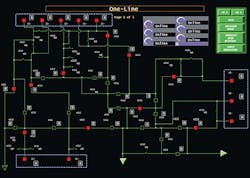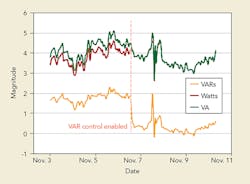Westar Energy was awarded a U.S. Department of Energy cofunded Smart Grid Investment Grant for its SmartStar Lawrence project. The three-year project consisted of installing advanced metering infrastructure, a meter data management system and distribution automation (DA).
The utility chose the city of Lawrence, Kansas, U.S., as the initial location for implementing this technology because of its size and customer base, which includes many higher-education student residents, commercial and industrial customers, and educational institutions. While Lawrence customers will be the first to benefit from these new capabilities, the utility plans to continue installing similar equipment throughout its service territory.
By implementing a pilot DA system, Westar Energy sought to achieve several important objectives:
• Increase system reliability
• Reduce outage restoration times
• Minimize distribution system losses
• Reduce system loadings during peak conditions
• Improve system operation and understanding
• Improve service to customers.
To minimize the impact on distribution system operators, Westar Energy also wanted to pass information from the DA system to the existing energy management system/supervisory control and data acquisition system (EMS/SCADA) so a separate interface would not be needed. This would enable operators to use the same system they were already intimately familiar with operating.
DA System Implementation
The DA system was implemented on 24 out of 1,338 circuits across the Westar Energy distribution network. The feeder circuits used reclosers at normally open tie points to interconnect two or more power sources. Additional reclosers were installed throughout the feeder circuits to enable sectionalizing capabilities in the event of permanent faults occurring on a line section. The system used the following equipment:
• 33 new SEL-651R advanced recloser controls and SEL-2401 satellite-synchronized clocks paired with G&W Electric reclosers
• One legacy Cooper recloser with Form 6 controls
• 53 S&C Electric capacitor bank controls retrofitted for existing capacitor banks
• 10 substation transformer load-tap changer (LTC) controls, six of which needed to be upgraded
• 39 existing non-telemetered switches
• 87 Sierra Wireless 3G and 4G cellular modems for feeder intelligent electronic device (IED) communications and control
• One SEL-3530 real-time automation controller as a distribution automation controller (DAC), providing centralized system intelligence
• One SEL-3620 Ethernet security gateway that provides comprehensive security measures, including IED password management.
The SEL DAC communicates with the substation transformer LTCs and protective relays by messages relayed through the EMS/SCADA system to the substation remote terminal units. To maintain awareness of the system configuration, a server-based software solution monitors the utility’s outage management system and provides the status of the non-telemetered switches in the system back to the DAC, thus maintaining awareness of abnormal operating system conditions.
Several communications protocols were implemented across the system, including DNP3, SEL and Modbus. The protocols were selected either because of legacy equipment limitations or because they provide desired IED functionality. The DAC also acts as a protocol converter, enabling the various IEDs in the DA scheme to communicate and operate together as a holistic system. Additionally, the DAC provides port-routing functionality for remote-access capabilities using various proprietary vendor software interfaces. This enables a mix of new and legacy IEDs as well as controllers from different equipment manufacturers to be used, thus minimizing the installation time and the cost of implementing the system.
Because the automation system was being deployed primarily for system restoration and voltage control, high-speed communications were not required. All protective functions are performed locally within the IEDs, so the loss of communications would be acceptable, although not desirable.
Cellular communications enabled Westar Energy to minimize deployment times because there was no back-end infrastructure to build and maintain. Although there were ongoing data charges, data rate plans were negotiated with the cellular providers that offset the costs that would have been associated with a utility-owned system. Additionally, the cellular network is being built continually to incorporate new technologies with increasing data throughput rates and decreasing data plan costs.
Westar Energy implemented the SEL distribution network automation (DNA) system in two phases, starting with the fault location, isolation and service restoration (FLISR) capability (phase one) and then adding volt/VAR control capability (phase two). This enabled the reclosers to be installed initially, followed by the replacement of capacitor bank controls and LTC integration at a later time. SEL provided the initial FLISR and volt/VAR programming by creating a system model and configuring standard DNA libraries for the Westar Energy distribution system.
Human-machine interface (HMI) displays were developed for use during commissioning and testing. SEL also provided remote interactive training so engineers at Westar Energy would be proficient at maintaining and implementing changes to the system to accommodate additional IEDs or feeder circuits in the future. Westar engineers further developed and implemented features in the system, including the deployment of automated password management, remote IED management capabilities, automated SMS/e-mail routines and additional HMIs to aid with routine system monitoring and operations.
DNA System Capabilities
The phase one portion of the Westar Energy system provided centralized automated controls that perform autonomous FLISR activities. As part of the FLISR functionality, the SEL solution included the following features:
• Loss-of-source detection
• Open-phase detection
• Miscoordination detection and mitigation (provides operator notification and sectionalizes the correct portion of the system with the fault)
• Overload mitigation and load shedding (smartly selects an alternate source with available capacity, shifts sources if loading increases beyond the limits or sheds load if no alternate sources with capacity are available).
In phase two, automation and control for voltage and reactive power flow were implemented. The implementation used the same centralized system DAC and feeder information but added control of voltage regulators, capacitor banks and substation transformer LTCs to the system model. This simplified the effort to add volt/VAR control while enabling both systems to operate as an integrated system. A benefit of implementing the system in this manner was that even after system reconfiguration, volt/VAR capabilities could still be performed on the reconfigured system.
The SEL volt/VAR capabilities also included several additional features:
• Minimized VAR flow (system losses)
• Voltage operating limits flattened across feeders, resulting in feeder voltage reductions while not exceeding the minimum voltage limits to end-use customers
• Feeder voltage reductions that resulted in reduced energy consumption during peak demand (dependent on load characteristics), also known as conservation voltage reduction
• Flexible operator control modes to do the following:
- Optimize voltage on the feeder
- Optimize power factor on the feeder and on the station bus
- Provide demand response for peakload reduction
- Optimize VAR set point on the primary side of the transformer for transmission VAR support.
System Features in Action
A benefit of having secure communications to substation and feeder devices is it enables remote engineering access. Now engineers are able to retrieve and change IED settings as well as pull event data (sequential event records and oscillography) from all devices on a feeder circuit, facilitating faster event analysis as well as helping to refine settings for improved system operation and protection.
Westar Energy also has implemented automated password management and automated SMS text and e-mail messaging routines for configured alarms and events.
Since the system was placed into service, multiple isolation and restoration incidents have occurred, resulting in reduced outages to customers. In one instance, a ground wire located on the primary line between the substation breaker and the first downstream recloser failed and caused the circuit to lock out. The DAC initiated isolation of the faulted section and closed a normally open recloser to restore power to 894 customers fed from an alternate feeder source in less than two minutes. In another instance, a fault resulting from a failed insulator was also successfully isolated and customers restored.
In addition, Westar used the DA system to identify a sympathetic fault on a feeder in the automation scheme. As a result of the remote data collection capabilities provided by the system, Westar engineers were able to identify a location upstream of a faulted line section where conductors were slapping together as a result of the magnetic fields associated with high fault current levels. The engineers believe similar intelligence can be designed into the system so this process of fault identification can be automated in the coming years.
Another benefit realized as a result of the addition of reclosers and recloser controls to the DA system is the reduction in customer interruptions, even without FLISR system interaction. To date, the reclosers and automation system have eliminated more than 333,000 customer minutes interrupted.
Lessons for the Future
Westar Energy learned some valuable lessons from this project that will be incorporated in future projects:
• Building relationships with information technology groups and personnel involvement — including information technology security — was instrumental in successfully designing and securing the system.
• Cross-functional communication between the various interacting groups was key, beginning in the early stages of the project.
• New devices deployed en masse, in contrast to a small trial installation, resulted in some challenges with wildlife protection (faults experienced that required rework).
• The use of cellular modems required some communications handshaking and latency issues to be overcome, some of which required vendor firmware modifications.
• Autonomous (closed-loop) system acceptance by operating groups was aided by education and training, and was a key part of the implementation.
• Fault-bit logic in SEL recloser controls and protective relays is useful for identifying fault locations and miscoordination events. This technology could be used as an early warning system for problem areas.
A Successful Start
The Lawrence area is realizing the benefit of improved system reliability, which includes fewer outages and a reduction in outage durations as a result of faster restoration to unfaulted line sections. This benefits both the customers and Westar Energy, thus creating a win-win project.
Westar Energy implemented the DNA system, which is providing a capable and fully automated FLISR and volt/VAR distribution solution. The system has the ability to translate between various communications protocols and seamlessly interface with Westar’s existing EMS system. The DNA system leverages some of Westar’s existing legacy equipment as well as positions the utility for future deployments.
Using the DAC and security gateway hardware at Westar Energy has opened the door to a systemwide deployment of communications devices across the utility’s entire territory. The DNA system was designed to maximize system effectiveness, enable improved system awareness and increase work efficiencies across the utility, primarily as a result of the new remote access capabilities.
Through collaboration between SEL and Westar Energy, the Lawrence SmartStar DA project was a key success and has provided valuable experience that will be leveraged as Westar continues to expand DA to other parts of its system.
Mike Watson is the director of distribution operational technologies at Westar Energy. He has more than 26 years of utility industry experience. He received his BSEET degree from Oklahoma State University and spent the first 10 years of his career in power system design and systems engineering in the nuclear environment. The following 16 years of his career have been focused on various aspects of the electric distribution field, including power system design and planning, operations, power-quality impacts and system automation. He is a professional engineer in Oklahoma.
Jeff Hauber is a senior engineer in the distribution automation/technologies group at Westar Energy. He received a BSEE degree from the University of Kansas in 2005. He started at Westar Energy as a distribution engineer with responsibilities including planning, coordination, design, power quality and reliability. He began working in the distribution automation group in 2013. He is a professional engineer in Kansas and a member of IEEE.
Clayton Stubbs is a distribution automation engineer at Westar Energy. He received a BSEE degree from Kansas State University in 2012. Stubbs began working for Westar Energy in 2011 as an intern and became a full-time employee upon graduation. He is a member of IEEE and received an Intern Engineer certificate in the state of Kansas.






